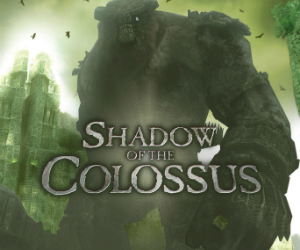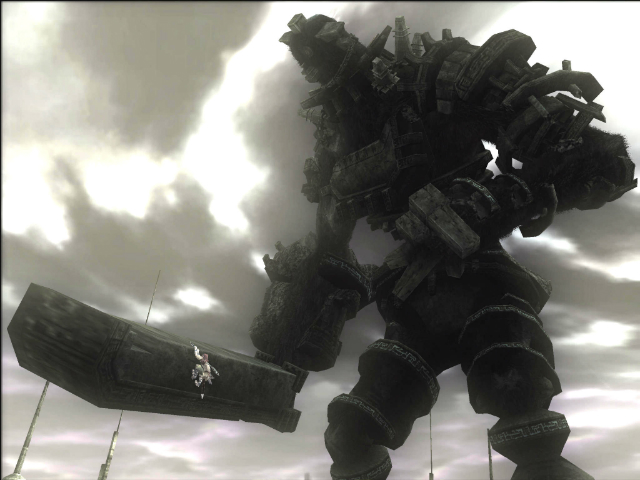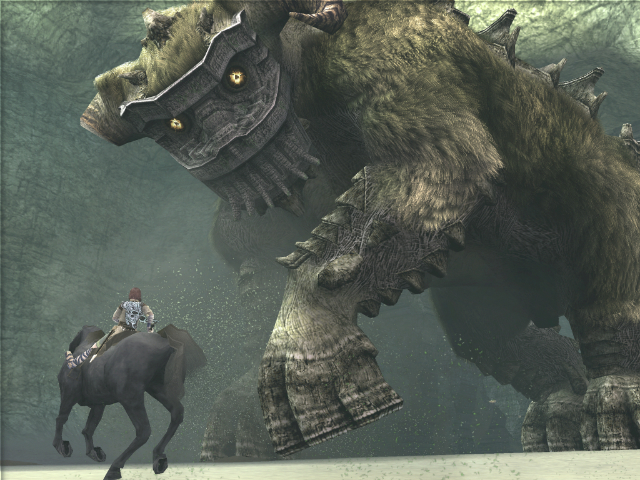A Look Back at Shadow of the Colossus
 If you’ve spent any amount of time discussing video games with me (and if so, I pity you) then chances are I’m going to have mentioned Shadow of the Colossus. Still holding a firm place in the ever-shifting list of my top ten favourite games, I was ridiculously excited when HD versions of both it and Ico were announced (this excitement made even more ridiculous by the fact that I then, and still, do not have reliable access to a PS3 and HD TV), spending far too long trying to take in as much of its hi-res shininess as I could when I finally got the chance to actually play it at Eurogamer Expo 2011. Predictably, I made a fool of myself while dispatching the very first colossus (there were murmurs of performance anxiety from my friends in response to me insisting that this never usually happened), but there was no doubt about it: shiny it was.
If you’ve spent any amount of time discussing video games with me (and if so, I pity you) then chances are I’m going to have mentioned Shadow of the Colossus. Still holding a firm place in the ever-shifting list of my top ten favourite games, I was ridiculously excited when HD versions of both it and Ico were announced (this excitement made even more ridiculous by the fact that I then, and still, do not have reliable access to a PS3 and HD TV), spending far too long trying to take in as much of its hi-res shininess as I could when I finally got the chance to actually play it at Eurogamer Expo 2011. Predictably, I made a fool of myself while dispatching the very first colossus (there were murmurs of performance anxiety from my friends in response to me insisting that this never usually happened), but there was no doubt about it: shiny it was.
As you probably already know, both games were developed by Fumito Ueda’s Team ICO, a division of SCE Japan Studio, and were originally released for the PS2 in 2001 (Ico) and 2005 (Shadow of the Colossus) respectively. I first found out about Ico after seeing a trailer on a demo disc, I remember being captivated by its haunting visuals and strange, lilting music. Its playstyle also looked so different from the vast majority of games available at the time, with an emphasis on puzzles and exploration with comparatively little combat. When I finally got hold of a copy of the game a couple of years later (or thereabouts), I was hooked. The game had its flaws (for example Yorda’s somewhat unpredictable AI, which could lead to all manner of fun and games in some of the shadow encounters) but by and large I found playing Ico an enjoyable experience; an opinion most critics also seemed to share.

With this in mind, it probably won’t come as much of a surprise that as soon as I heard about Shadow of the Colossus I was convinced that I had to have it. At that point I knew relatively little about it aside from the basic premise, but the fact that it was made by the people who had made Ico was more than enough to ensnare me.
I think it’s fair to say that Shadow of the Colossus was, and still is, unlike anything I’d ever played before. It shared Ico’s minimalist aesthetics, although Colossus’s environment seemed far more open (perhaps largely due to it not being set exclusively within the confines of a castle), with the subtle implication of limitlessness. As in Ico the cast of characters was similarly small, only really featuring the protagonist, Wander, and his horse, Agro (Mono, the girl Wander has set out to save, doesn’t really count considering that she spends pretty much the entirety of the game dead). Aside from when you speak with Dormin, the enigmatic god-like entity who aids you in your quest, there is no dialogue.
In short, in Shadow of the Colossus you are made to feel alone. You’re one solitary man roaming the vast emptiness of the Forbidden Land, and if that doesn’t make you feel small then the massive colossi (and even the constant presence of the enormous Agro) certainly do.

The colossi themselves are, of course, the focal point of the game (although it could be argued that you spend more time riding around the rolling plains of the Forbidden Land than fighting them). However, if you have any heart at all then you’re likely to be less than thrilled about defeating them all. Indeed, certain colossi in particular aren’t even aggressive to begin with, treating you with curiosity or otherwise avoiding you, and regardless of their intentions towards you their deaths are all accompanied by the same mournful swells of the game’s impressive orchestral score (speaking of which, if you’ve never listened to ‘The Opened Way’ then go and do so right now).
With each colossus you defeat, Wander’s appearance gradually begins to change, and after the sixteenth has been slain his clothes are in rags, his skin deathly pale and two small horns are starting to sprout from his skull. Although Lord Emon and his men attempt to stop the inevitable, Wander’s body is taken over by Dormin, whose power, once sealed safely within the sixteen colossi, is now fully restored. The game’s final sequence, wherein you get to effectively become a colossus yourself before having to submit to the inevitability of your fate, is truly poignant.
Shadow of the Colossus did have its faults. For one, all the riding around with only the, often dodgy, directions of the sword to rely on could be incredibly frustrating. Additionally, some of the colossi in particular are prone to bugs and general behavioural peculiarities that could make defeating them incredibly difficult or even impossible without restarting the fight from the beginning. For these reasons, some players deemed the game’s admittedly somewhat repetitive pattern of ‘riding sequence, boss fight, rinse and repeat’ a little boring. However, provided you had a little determination (arguably what Shadow of the Colossus is all about) it was hard not to be drawn in by a game that was undeniably engaging despite its alleged simplicity.

With rumours of a film in the works (which, as with any film of a video game, I am admittedly dubious about) and The Last Guardian due out later this year (near my birthday, in fact; I know what I’ll be getting myself), there is still more to come from Team ICO. However, despite stating that he will stay on in order the finish work on The Last Guardian, Fumito Ueda’s departure from Sony in 2011 is bound to affect the future of the team (if, considering Ueda is its head, it has a future at all).




